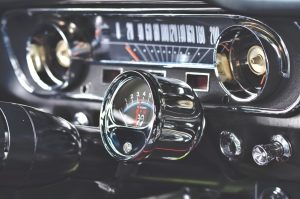
Most of us are familiar with the Ford Motor Company. We know them as the company that makes trucks, and maybe as the first automobile manufacturer in the world. But there’s a lot more to the Ford Motor company that you might not have heard.
Did you know that Henry Ford once tried to buy Ferrari, failed, and then beat the company later in the Le Mans races? Or did you know that the only car Jim Morrison ever owned was a 1967 Shelby GT 500? Read on to discover more fun Ford facts and what makes this company so remarkable.
Thomas Edison
Thomas Edison played a big role in the Ford company, from its first start to his final breath. Before Henry Ford became the most well-known name in American vehicles, he worked for Thomas Edison at the Edison Illuminating Company in Detroit, Michigan. Edison encouraged Ford to work on gasoline-powered engines when the idea caught his imagination.
Edison and Ford remained lifelong friends, and Ford considered Edison to be a mentor and an inspiration. The two were so close, in fact, that when the great inventor died, Henry Ford asked Edison’s son to capture his last breath in a glass tube. That tube is now on display at the Henry Ford Museum.
Natural Materials
Ford was one of the first companies to “go green” and use natural materials in its production. In fact, as early as the 1930s, Ford factories were using biofuels. The factories would burn human and animal waste as fuel, powering their machinery with renewable resources.
Ford also uses natural materials at the end of their process, though the folks at PETA might not exactly call this fact environmentally friendly. Ford uses ostrich feathers to dust their cars before they go in to be painted to ensure a perfect mirror finish. Ostrich feathers are excellent at capturing and holding dust, and each one can last up to five years.
From A to T
There’s a reason the first Ford model most of us are familiar with is the Model T. Henry Ford didn’t pick the letter at random; Ford went through nineteen unsuccessful models of car before their twentieth, the Model T, found success.
The first model of the car, the Ford Model A, had a two-cylinder engine. It had a top speed of 30 miles per hour, and sold for $850 in 1903 to Dr. Pfenning. That car is currently owned by Henry Ford’s great-grandson and the current CEO of the Ford company, William Clay Ford, Jr.
Fordlandia
The book Utopia was published in 1516 and has captured the imagination of the world ever since. Henry Ford was no exception; he dreamed of building a large rubber factory that would double as a perfect community. It would provide jobs to local workers and provide fresh rubber for his tire factories.
In 1928, Ford tried to make this dream a reality in the Amazonian jungle of Brazil. He called the village “Fordlandia,” but unfortunately the landscape there was too harsh, and the project failed. To this day, the land where Fordlandia was sits abandoned and uninhabited.
Fair Wages
If Ford couldn’t build a Utopia in the jungles of Brazil, he was going to do his best to build one at home. In 1914, the average wage for a worker was $2.50. Ford raised that amount to $5, a stunning measure that was unheard of for the time.
This decision turned out to be a spectacular one for the company. Employee satisfaction went through the roof, and productivity increased as a result. Not to mention Ford employees could then afford to buy one of the cars they helped to make, increasing company loyalty and sales all in one go.
Going Big
In 1975, people decided trucks weren’t big enough and didn’t have nearly enough car-crushing power. So they invented Bigfoot, the monster truck that kicked off decades of spectators watch trucks drive (and ramp) over the top of old cars. That first truck was built on a Ford F-series truck body.
But Henry Ford was thinking even bigger than monster trucks in his day. When World War II rolled around, Ford started branching off into building airplanes. The operation shut down in 1933, but the United States Centennial of Flight Commission recognized Ford as a pioneer of flight.
In Times of War
Airplanes weren’t the only contribution Ford and his company made to the war efforts. World War I was the first war to use automobiles, and that was due in part to the Ford Model T. They were used as ambulances, delivery trucks, and artillery transportation all over the front of World War I.
When World War II began, Ford was opposed to the United States getting involved, since he was a pacifist. But after Pearl Harbor, circumstances changed, and Ford made huge contributions to the war efforts. In addition to more than 86,000 aircraft, 57,000 airplane engines, and 4,000 gliders, Ford built more than 277,000 vehicles for the war effort.
The (Fourth) Largest Family Business
Ford’s beginnings were humble, and his family continues to operate on that same home-grown style. The family holds only a minority of the company’s money, but they do hold a majority of the power in the boardroom. So the Ford Motor Company is still controlled by the descendants of Henry Ford.
As of 2019, the Ford Motor Company is worth nearly $150 billion dollars. This makes them the fourth-largest family-run business in the world. The largest is Walmart, with an annual turnover of more than $485 billion.
Discover More Ford Facts
Ford is one of the most well-known companies and families in the United States. Henry Ford’s legacy is a testament to the American values of innovation, determination, and a pioneering spirit. Knowing these Ford facts is a great way to celebrate this great American legacy.



